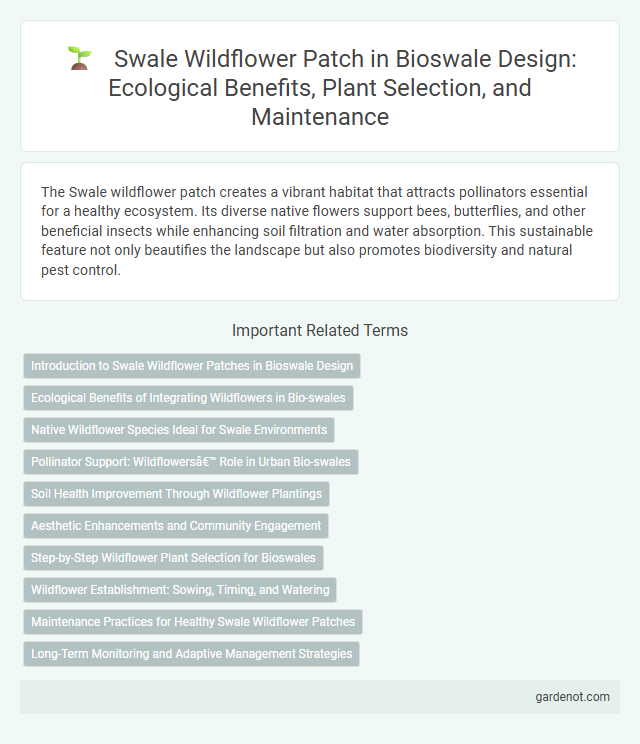The Swale wildflower patch creates a vibrant habitat that attracts pollinators essential for a healthy ecosystem. Its diverse native flowers support bees, butterflies, and other beneficial insects while enhancing soil filtration and water absorption. This sustainable feature not only beautifies the landscape but also promotes biodiversity and natural pest control.
Introduction to Swale Wildflower Patches in Bioswale Design
Swale wildflower patches play a crucial role in bioswale design by enhancing stormwater management and promoting biodiversity. These patches consist of native wildflowers that improve soil infiltration, filter pollutants, and provide habitat for pollinators. Integrating swale wildflower patches into bioswales supports sustainable urban landscapes while mitigating runoff and improving water quality.
Ecological Benefits of Integrating Wildflowers in Bio-swales
Swale wildflower patches enhance bio-swales by boosting biodiversity and providing vital habitats for pollinators such as bees and butterflies, which are crucial for ecosystem health. The deep-rooted wildflowers improve soil infiltration and nutrient uptake, reducing runoff and filtering pollutants more effectively. These ecological benefits contribute to sustainable stormwater management and promote resilient, thriving urban green spaces.
Native Wildflower Species Ideal for Swale Environments
Native wildflower species such as Echinacea purpurea, Asclepias tuberosa, and Rudbeckia hirta thrive in swale environments due to their adaptability to periodic moisture and well-drained soils. These species support local pollinators, enhance biodiversity, and contribute to effective stormwater management by stabilizing soil and filtering runoff. Incorporating native wildflowers in swale designs promotes ecological resilience while creating visually appealing and sustainable green infrastructure.
Pollinator Support: Wildflowers’ Role in Urban Bio-swales
Swale wildflower patches play a crucial role in supporting pollinators by providing diverse nectar and pollen sources essential for bees, butterflies, and other beneficial insects. These native wildflowers enhance urban bio-swales by improving biodiversity, promoting ecological resilience, and increasing pollinator visitation rates critical for healthy urban ecosystems. Integrating wildflowers into swale designs strengthens natural pest control and fosters sustainable environmental benefits in city landscapes.
Soil Health Improvement Through Wildflower Plantings
Swale wildflower patches enhance soil health by increasing organic matter and promoting microbial diversity, which improves nutrient cycling and soil structure. Deep-rooted wildflowers aid in aeration and water infiltration, reducing soil compaction and erosion in bio-swale systems. These plantings support a resilient soil ecosystem, contributing to long-term sustainability and effective stormwater management.
Aesthetic Enhancements and Community Engagement
Swale wildflower patches offer significant aesthetic enhancements by transforming ordinary drainage areas into vibrant, colorful landscapes filled with native wildflowers that attract pollinators and wildlife. These patches foster community engagement through volunteer planting events, educational workshops, and citizen science projects, encouraging local stewardship and environmental awareness. By integrating ecological function with visual appeal, swale wildflower patches create inviting public spaces that strengthen neighborhood connections and promote sustainable urban ecosystems.
Step-by-Step Wildflower Plant Selection for Bioswales
Selecting wildflowers for bioswales involves choosing native species that thrive in moist, well-drained soils and support local pollinators like bees and butterflies. Prioritize drought-tolerant plants such as purple coneflower (Echinacea purpurea), black-eyed Susan (Rudbeckia hirta), and swamp milkweed (Asclepias incarnata) to enhance water filtration and habitat diversity. Incorporate a mix of early, mid, and late bloomers to ensure continuous seasonal interest and optimize ecological benefits throughout the growing season.
Wildflower Establishment: Sowing, Timing, and Watering
Swale wildflower patches require precise wildflower establishment through careful sowing techniques, optimal timing during early spring or fall, and consistent watering to ensure seed germination and growth. Selecting drought-tolerant and native wildflower species enhances resilience, while maintaining moist but not waterlogged soil encourages robust root development. Proper timing aligns with seasonal rainfall patterns, reducing irrigation needs and promoting sustainable, low-maintenance swale ecosystems.
Maintenance Practices for Healthy Swale Wildflower Patches
Regular mowing and selective weeding prevent invasive species from overwhelming the swale wildflower patch while promoting native biodiversity. Periodic soil testing ensures nutrient levels remain balanced, supporting robust plant growth and resilient root systems. Seasonal inspections help identify pest issues early, allowing targeted interventions that protect the ecological health of the swale.
Long-Term Monitoring and Adaptive Management Strategies
Long-term monitoring of swale wildflower patches involves regular assessment of plant diversity, soil health, and hydrological performance to ensure ecosystem resilience. Adaptive management strategies include periodic species composition adjustments and invasive species control based on monitoring data to maintain optimal ecological balance. Integrating real-time environmental sensor data enhances decision-making for sustaining swale function and biodiversity over time.
Swale wildflower patch Infographic

 gardenot.com
gardenot.com